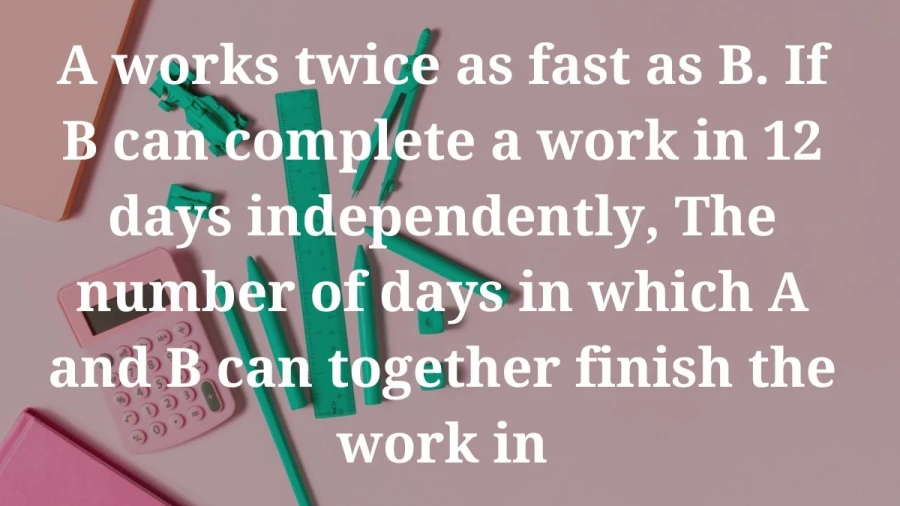If you happen to be viewing the article A works twice as fast as B. If B can complete a work in 12 days independently, The number of days in which A and B can together finish the work in ? on the website Math Hello Kitty, there are a couple of convenient ways for you to navigate through the content. You have the option to simply scroll down and leisurely read each section at your own pace. Alternatively, if you’re in a rush or looking for specific information, you can swiftly click on the table of contents provided. This will instantly direct you to the exact section that contains the information you need most urgently.
A works twice as fast as B. If B can complete a work in 12 days independently, The number of days in which A and B can together finish the work in
A and B together can finish the work in 4 days.
Let’s denote the rate at which B works as “b” (in terms of completing the job per day).
If B can complete a work independently in 12 days, then:
b = 1/12
Since A works twice as fast as B, the rate at which A works would be twice the rate of B, so:
a = 2b
a = 2 * (1/12)
a = 1/6
Now, if A and B work together, their combined rate would be the sum of their individual rates:
a + b = 1/6 + 1/12
a + b = 2/12 + 1/12
a + b = 3/12
a + b = 1/4
So, A and B together can complete 1/4 of the work per day. To find out how many days it takes for them to finish the work together, we’ll take the reciprocal of their combined rate:
Article continues below advertisement
Number of days = 1 / Combined rate
Number of days = 1 / (1/4)
Number of days = 4
So, A and B together can finish the work in 4 days.
Time and Work in Mathematics
Time and work problems in mathematics deal with calculating the amount of work done by people, machines, or any other entities working together or separately within a certain time frame. These problems often involve rates of work, time taken, and the combined effort of multiple entities.
Article continues below advertisement
Article continues below advertisement
Here are some key concepts and strategies to solve time and work problems:
-
Work Rate: Work rate is the amount of work done per unit time. It’s usually expressed in terms of “work per unit time,” such as units of work per hour.
-
Basic Formula: The basic formula to calculate work is: Work = Rate × Time. Rearranging this formula, you can find the time taken or the rate of work if the other two variables are known.
-
Inverse Proportionality: Time and work are inversely proportional. That means if the number of workers increases, the time taken to complete the work decreases, and vice versa.
-
Combined Work: When multiple entities are working together or sequentially on a task, you need to consider their individual rates of work and the time they work together or separately.
-
Fractional Work: Sometimes, a fraction of work is done, and the remaining work needs to be completed. This often happens when someone joins or leaves the work midway.
-
Solving Strategies: When solving time and work problems, it’s helpful to define variables for unknown quantities, set up equations based on the given information, and solve for the unknowns using algebraic manipulation.
-
Common Patterns: Look for common patterns like “A does twice the work of B” or “A and B together complete the work in 6 hours.” These patterns can help you set up equations and solve the problem more efficiently.
Let’s illustrate with an example:
Example: If it takes 8 hours for 12 workers to build a house, how many hours will it take for 18 workers to build the same house assuming they work at the same rate?
Solution: Let R be the rate of work for each worker. So, for 12 workers, the total rate of work is 12R.
Given that they complete the work in 8 hours, the total work done is 8 × 12R = 96R.
Now, for 18 workers, we need to find out how many hours it takes to complete the same work at the same rate. Let T be the time taken.
So, 18 × T × R = 96R (because the total work done should be the same).
Solving for T:
18T = 8
T = 8/18 = 4/9 hours.
So, it will take 4/9 hours for 18 workers to build the same house.
These are the fundamental principles and techniques you can apply to solve various time and work problems in mathematics.
Thank you so much for taking the time to read the article titled A works twice as fast as B. If B can complete a work in 12 days independently, The number of days in which A and B can together finish the work in written by Math Hello Kitty. Your support means a lot to us! We are glad that you found this article useful. If you have any feedback or thoughts, we would love to hear from you. Don’t forget to leave a comment and review on our website to help introduce it to others. Once again, we sincerely appreciate your support and thank you for being a valued reader!
Source: Math Hello Kitty
Categories: Math

